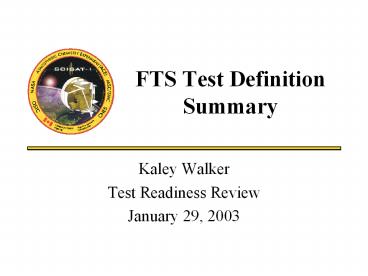FTS%20Test%20Definition%20Summary - PowerPoint PPT Presentation
Title:
FTS%20Test%20Definition%20Summary
Description:
Cycle between SCIENCE and SLEEP mode as for nominal occultation ... Monitor channel for recurrence of problem. Contamination Monitoring (Priority 1) ... – PowerPoint PPT presentation
Number of Views:25
Avg rating:3.0/5.0
Title: FTS%20Test%20Definition%20Summary
1
FTS Test Definition Summary
- Kaley Walker
- Test Readiness Review
- January 29, 2003
2
What Needs to be Done
- Performance testing of
- Passive cooler / detectors
- Suntracker / co-registration
- Imagers
- Spectrometer (ILS, FOV etc.)
3
Passive Cooler
- Evaluate performance of passive cooler using He
cooled target - Monitor detector and target temperatures
- While cooling from room temperature
- During instrument temperature transitions
- Priority 1
4
Detector Temperature
- Measure while cooling detector every 5 K from
110 ? 70? K - High resolution spectra N2O gas cell
- Examine ILS vs. T and estimate NESR
- Retrieve temperature and pressure
- Low resolution spectra
- Bandpass characteristics
- Priority 1
5
Detector Non-linearity
- Measure while cooling detector every 5 K from
110 ? 70? K - Low resolution interferograms
- At 1750, 2250, 2750 K ( 3273 K from previous)
- Ratio of centre burst to first side lobe to
calculate - 5800 K point measured on orbit
- Priority 1
6
Operational Cycling
- Measure at 90 K and lowest achieved T
- Simulate normal operational power dissipation
- Cycle between SCIENCE and SLEEP mode as for
nominal occultation - Monitor detector temperature for any changes in
cooling rate - Priority 3
7
Detector Monitoring
- InSb Instability (Priority 1)
- Monitor channel for recurrence of problem
- Contamination Monitoring (Priority 1)
- Measure low resolution spectra every 12 hours
using 2273 K HBB - Need criteria for when decontamination should be
initiated
8
Suntracker
- Sunscan exercise mode using typical scan for
MAESTRO calibration (Priority 1) - Stability measure in closed loop with sunrise
simulator (50 s occultation) (Priority 2) - Pointing characterize pointing over 1.5
range using leapfrog technique (Priority 2)
9
Co-registration
- MAESTRO to VIS (Priority 2)
- On bench with 532 nm laser source and in TVac
with Xe lamp and pinhole - FTS to NIR (Priority 2)
- Combined QI / HBB source and pinhole
- NIR to VIS Registration (Priority 3)
- relative orientation and pixel offset between
arrays
10
Imager Characterization
- Flat Field Bench
- Solar simulator to provides uniform illumination
(Priority 2) - Flat Field TVac
- Illuminate stepwise using QI source
(Priority 2) - Non-linearity TVac
- Stepwise illumination and vary attenuation
(Priority 2)
11
Imager Charaterization
- Gain characterize imager settings (Priority 2)
- Dark Current measure versus instrument
temperature perform prior to each test with
imagers (Priority 2) - Cropping test modes with sunrise simulator and
attenuated source (Priority 3)
12
Gas Cell Measurements
- Combined Measure NO2 and O3 with both FTS and
MAESTRO (Priority 2) - compare retrieved temperature and pressure values
- Additional N2O measurements with FTS at
instrument temperature plateaux (Priority 2) - Examine ILS vs. T and estimate NESR
- Retrieve temperature and pressure
13
Gas Cell Measurements
- Occultation Use suntracker to follow simulated
occultation and measure FTS (and MAESTRO) spectra
(Priority 3) - Have to step through occultation to allow for
time for sufficient coadds - Suntracker pointing in closed-loop at fixed
source - Somewhat unwieldy test that cannot provide test
as we fly conditions
14
FTS Tests
- IR FOV Move shutter stepwise across FOV and
measure ZPD (Priority 2/3) - Non-uniform FOV Illumination Use split
attenuator to observe ILS effects (Priority 3) - Modulation Efficiency To be done by Bomem
(Priority 2)
15
Limit in Testing
- HBB cavity lifetime 30-40 minutes at 3273 K and
we only have 4 cavities - Almost all tests done at max. temperature
- Priority 1 57 minutes
- Priority 2 65 minutes
- Priority 3 268 minutes
- Majority of 3 is Occultation 223 minutes
- without it we should have enough HBB lifetime to
complete testing program
16
Issues
- Detector Decontamination
- Need criteria for when this should be initiated
- Occultation test
- Significant drain on HBB lifetime
- Recommend deleting from test schedule































